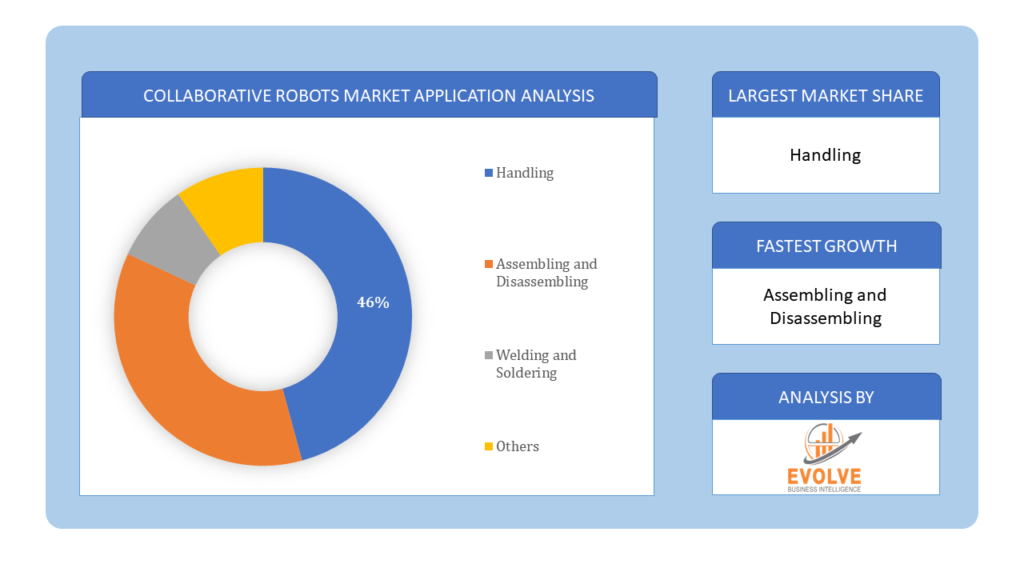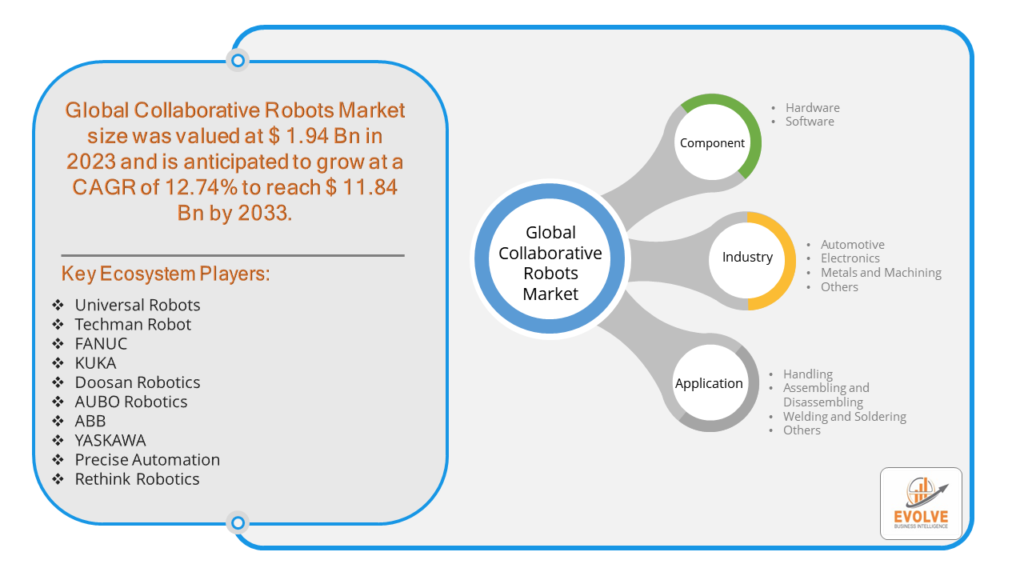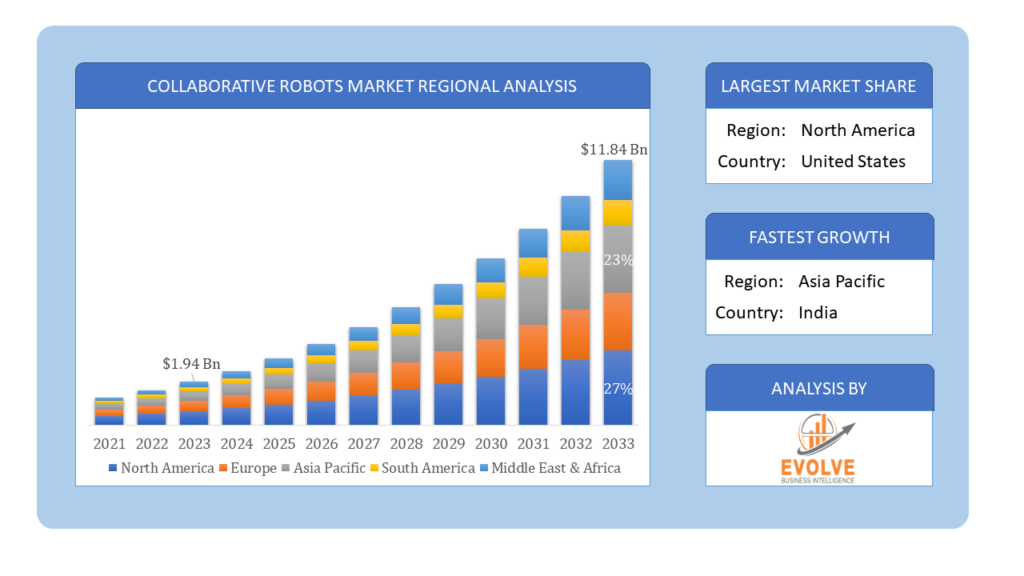Collaborative Robots Market Overview
The Collaborative Robots Market Size is expected to reach USD 11.84 Billion by 2033. The Collaborative Robots industry size accounted for USD 1.94 Billion in 2023 and is expected to expand at a compound annual growth rate (CAGR) of 12.74% from 2023 to 2033. The collaborative robots market refers to the industry segment focused on the development and deployment of robots designed to work alongside humans in various applications. These robots are equipped with advanced sensors and safety features that enable safe interaction with humans without the need for physical barriers. They are used across manufacturing, healthcare, logistics, and other industries to enhance productivity, improve efficiency, and streamline operations. The market is driven by increasing automation trends, demand for flexible and agile production processes, and advancements in artificial intelligence and robotics technology.
Global Collaborative Robots Market Synopsis
The COVID-19 pandemic has led to supply chain disruptions leading to supply shortages or lower demand in the Collaborative Robots market. The travel restrictions and social-distancing measures have resulted in a sharp drop in consumer and business spending and this pattern is to continue for some time. The end-user trend and preferences have changed due to the pandemic and have resulted in manufacturers, developers, and service providers to adopt various strategies to stabilize the company.
Global Collaborative Robots Market Dynamics
The major factors that have impacted the growth of Collaborative Robots are as follows:
Drivers:
⮚ Flexibility and Adaptability
Cobots are designed to be highly flexible and easily re-deployable for different tasks or production lines. This agility is crucial in industries where production needs can change rapidly, allowing companies to quickly adjust their operations without significant downtime or reconfiguration costs.
Restraint:
- Task Complexity and Customization
Cobots are well-suited for repetitive and ergonomic tasks, but complex or highly variable tasks may still require human intervention or more sophisticated robotic solutions. Limitations in adaptability and customization capabilities can restrict their application in diverse manufacturing environments..
Opportunity:
⮚ Expansion into Small and Medium-sized Enterprises (SMEs)
SMEs represent a significant growth opportunity for cobots due to their lower initial costs, ease of integration, and flexibility. Cobots enable SMEs to automate specific tasks or processes without requiring extensive infrastructure changes, making automation more accessible and cost-effective.
Collaborative Robots Market Segment Overview
By Application
 Based on the Application, the market is segmented based on Handling, Assembling and Disassembling, Welding and Soldering, Others. Assembling and disassembling tasks follow, leveraging robots for intricate assembly processes. Welding and soldering applications also show significant growth, driven by cobots’ ability to ensure consistent quality and safety in manufacturing operations.
Based on the Application, the market is segmented based on Handling, Assembling and Disassembling, Welding and Soldering, Others. Assembling and disassembling tasks follow, leveraging robots for intricate assembly processes. Welding and soldering applications also show significant growth, driven by cobots’ ability to ensure consistent quality and safety in manufacturing operations.
By Component
Based on the Component, the market has been divided into Hardware, Software. In the collaborative robots market, hardware components such as robot arms and sensors dominate, essential for physical interaction and automation tasks. Software components, crucial for programming and control, complement hardware functionalities, driving operational efficiency and flexibility in diverse industrial applications.
By Industry
Based on Industry, the market has been divided into Automotive, Electronics, Metals and Machining, Others. In the collaborative robots market, the Automotive sector holds a significant share, driven by automation needs in assembly and manufacturing processes. The Electronics industry follows closely, leveraging cobots for precise handling and testing tasks.
Global Collaborative Robots Market Regional Analysis
Based on region, the market has been divided into North America, Europe, Asia-Pacific, the Middle East & Africa, and Latin America. The area of North America is anticipated to dominate the market for the usage of Collaborative Robots, followed by those in Asia-Pacific and Europe.
 Collaborative Robots North America Market
Collaborative Robots North America Market
North America dominates the Collaborative Robots market due to several factors. In North America, the collaborative robots market is experiencing robust growth driven by increasing automation demands across various industries. The region is characterized by a strong presence of automotive manufacturers adopting cobots for assembly and handling tasks, aiming to enhance production efficiency and flexibility. The electronics sector in North America also embraces collaborative robots for precision manufacturing and testing processes. Additionally, industries such as food and beverage, pharmaceuticals, and logistics are increasingly integrating cobots to streamline operations and ensure compliance with stringent safety standards. The market is further propelled by advancements in technology and favorable government initiatives supporting automation and robotics adoption.
Collaborative Robots Asia Pacific Market
The Asia-Pacific region has been witnessing remarkable growth in recent years. In the Asia-Pacific region, the collaborative robots market is burgeoning with rapid industrialization and automation across diverse sectors. Countries like China, Japan, and South Korea are at the forefront, driving significant adoption of cobots in manufacturing industries. The automotive sector in these countries utilizes collaborative robots extensively for assembly and handling tasks, improving production efficiency and reducing costs. Electronics manufacturing also plays a crucial role, leveraging cobots for precise assembly and testing processes. Moreover, industries such as food and beverage, pharmaceuticals, and logistics in the region are increasingly integrating cobots to enhance operational efficiency and meet growing consumer demands.
Competitive Landscape
The competitive landscape includes key players (tier 1, tier 2, and local) having a presence across the globe. Companies such as Universal Robots, Techman Robot, FANUC, KUKA, and Doosan Robotics are some of the leading players in the global Collaborative Robots Industry. These players have adopted partnership, acquisition, expansion, and new product development, among others as their key strategies.
Key Market Players:
- Universal Robots
- Techman Robot
- FANUC
- KUKA
- Doosan Robotics
- AUBO Robotics
- ABB
- YASKAWA
- Precise Automation
- Rethink Robotics
Key development:
November 2023: Universal Robots launched the UR30, a high-performance cobot with a 30 kg payload, expanding their product line for heavier tasks.
October 2023: Universal Robots partnered with Denali Advanced Integration, a leading system integrator, to offer cobot solutions through an Automation-as-a-Service (AaaS) model.
July 2023: Universal Robots unveiled the UR20, their next-generation cobot offering faster speeds, higher precision, and improved user experience.
Scope of the Report
Global Collaborative Robots Market, by Application
- Handling
- Assembling and Disassembling
- Welding and Soldering
- Others
Global Collaborative Robots Market, by Component
- Hardware
- Software
Global Collaborative Robots Market, by Industry
- Automotive
- Electronics
- Metals and Machining
- Others
Global Collaborative Robots Market, by Region
- North America
- US
- Canada
- Mexico
- Europe
- UK
- Germany
- France
- Italy
- Spain
- Benelux
- Nordic
- Rest of Europe
- Asia Pacific
- China
- Japan
- South Korea
- Indonesia
- Austalia
- Malaysia
- India
- Rest of Asia Pacific
- South America
- Brazil
- Argentina
- Rest of South America
- Middle East & Africa
- Saudi Arabia
- UAE
- Egypt
- South Africa
- Rest of Middle East & Africa
| Parameters | Indicators |
|---|---|
| Market Size | 2033: $11.84 Billion/strong> |
| CAGR | 12.74% CAGR (2023-2033) |
| Base year | 2022 |
| Forecast Period | 2023-2033 |
| Historical Data | 2021 |
| Report Coverage | Revenue Forecast, Competitive Landscape, Growth Factors, and Trends |
| Key Segmentations | Application, Component, Industry |
| Geographies Covered | North America, Europe, Asia-Pacific, Latin America, Middle East, Africa |
| Key Vendors | Universal Robots, Techman Robot, FANUC, KUKA, Doosan Robotics, AUBO Robotics, ABB, YASKAWA, Precise Automation, Rethink Robotics |
| Key Market Opportunities | • Advancements in machine learning, edge computing, and robotics industry |
| Key Market Drivers | • Collaborative robots are capable of various light and heavy lifting tasks which drives their adoption among large, small and medium sized enterprises.Increasing labor costs worldwide in agriculture, manufacturing, and construction industries. |
REPORT CONTENT BRIEF:
- High-level analysis of the current and future Collaborative Robots Industry trends and opportunities
- Detailed analysis of current market drivers, restraining factors, and opportunities analysis in the future
- Historical market size for the year 2021, and forecast from 2023 to 2033
- Collaborative Robots market share analysis for each segment
- Competitor analysis with a comprehensive insight into its product segment, financial strength, and strategies adopted.
- Identifies key strategies adopted by the key players including new product development, mergers and acquisitions, joint ventures, collaborations, and partnerships.
- To identify and understand the various factors involved in the global Collaborative Robots market affected by the pandemic
- To provide year-on-year growth from 2022 to 2033
- To provide short-term, long-term, and overall CAGR comparison from 2022 to 2033.
- Provide Total Addressable Market (TAM) for the Global Collaborative Robots Market.







